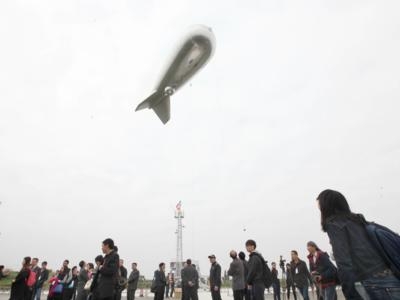Tethered Airship Provides Communication And Internet Access Services
With a commercial contract of HK$180 million (approx $23 million U.S.), the city-level Cloud space information platform, a prominent product of KuangChi Science's intelligent urban space business, completed its first commercial flight globally and started its first commercial operation on Dec. 28, 2015 in Dongguan, South China's Guangdong Province. Some 100 people, including Dongguan mayor Yuan Baocheng and KuangChi chairman Liu Ruopeng, witnessed the Cloud's ascent at Dongguan Eco Park.

The flight marks a major milestone in urban space technology. Measuring 48 meters long and nearly 20 meters high, the spectacular platform buoyed by helium rose to 300 meters above the ground, providing integrated services such as communications, Internet access, as well as big-data collection and analysis.
Licensed to fly within the eco park, the Cloud can be compared to a super tall communication tower or a low-flying satellite. It's anchored to the ground by a synthetic cable, which also serves as a portal to access the data processing center. Waterproof, designed with protection against the lightning and resisting changes in pressures and temperatures, the airship takes three hours to fill. It can resist winds at 20 meters per second when flying and those at 25 meters per second when anchored.
Luan Lin, chief technology officer of KuangChi Science, said that the system can be widely used in geographical surveying, traffic and wildfire monitoring, natural disasters and rescue missions.
The key technology and equipment used in the Cloud helped save the life of Tian Zeming, a survivor of a devastating landslide accident in Guangming, Shenzhen. The multi-functional high-resolution monitors from Cloud helped locate the buildings buried in the landslide and keep records of the excavation. With the help of the monitors and the Cloud mini -- a compact version of the Cloud used in emergencies, rescuers identified 22 locations for further excavation. Tian was found in a building at the location numbered 1.
Safe, cost-efficient and environment-friendly, the Cloud can rise to between 1,000 and 2,000 meters above the ground carrying a payload of 400 kilograms. Tailored to various needs, the payload can include wireless base stations, Super Wi-Fi equipment, TV and Radio transmitters, allowing the system to be used in a range of missions like telecommunications, urban planning and management, air pollution monitoring and maritime surveillance.
High in the air, the Cloud covers a wider range and transmits signals far better than ground systems. In Dongguan's case, the system's Wi-Fi communication capacity covers a radius of 30 kilometers, and the total areas covered can reach 3,000 square kilometers combined with ground relays.
The disruptive technology used in the Cloud is similar to that developed by Raytheon Company, a U.S. defense contractor, whereas Raytheon's technology is confined to military use. The Cloud is the first of its kind in civilian areas.
During a test launch in Shenzhen in February, the Cloud successfully performed its tasks in Wi-Fi communication coverage, ground monitoring and maritime data collection.
With more functions and more stable performance, the system used in Dongguan will help monitor the PM 2.5 levels in the air, safeguard security in crowded areas and intelligently maneuver urban traffic. The Internet of things network and Wi-Fi coverage provided by the system will make life easier and better for Dongguan's citizens.
Part of KuangChi's "Global Community of Innovation" (GCI) initiative, the Cloud is another attempt to bring sci-fi technologies to fruition. The GCI partners also include the Martin Jetpack, Near Space Traveller, Space Levitation Station, Solarship, Zwipe, HyalRoute Broadband, Parallel World, iPhoton, Super WiFi and Smart Structure.
(Image provided with KuangChi Science news release)
 ANN's Daily Aero-Term (05.05.24): Omnidirectional Approach Lighting System
ANN's Daily Aero-Term (05.05.24): Omnidirectional Approach Lighting System Aero-News: Quote of the Day (05.05.24)
Aero-News: Quote of the Day (05.05.24) Airborne 05.06.24: Gone West-Dick Rutan, ICON BK Update, SpaceX EVA Suit
Airborne 05.06.24: Gone West-Dick Rutan, ICON BK Update, SpaceX EVA Suit Airborne 05.03.24: Advanced Powerplant Solutions, PRA Runway Woes, Drone Racing
Airborne 05.03.24: Advanced Powerplant Solutions, PRA Runway Woes, Drone Racing Aero-News: Quote of the Day (05.06xx.24)
Aero-News: Quote of the Day (05.06xx.24)



